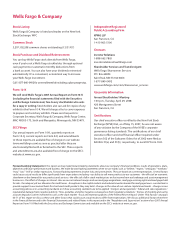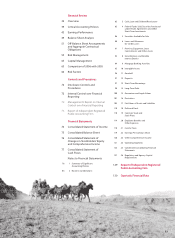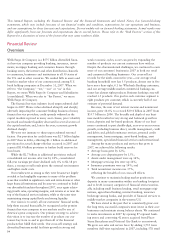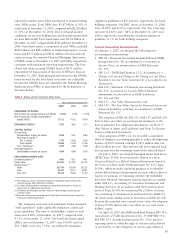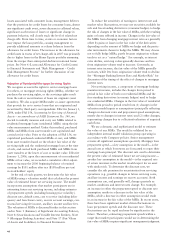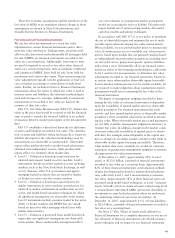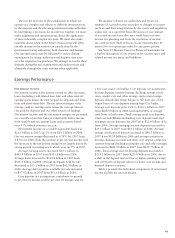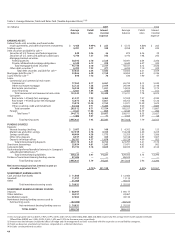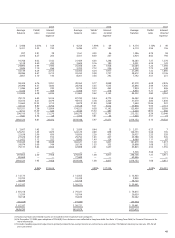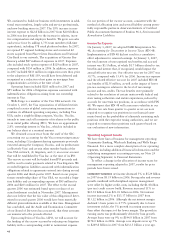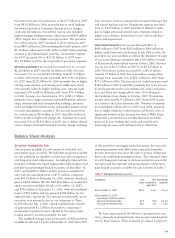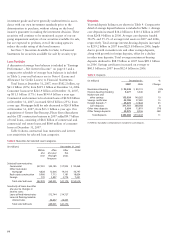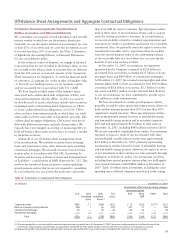Wells Fargo 2007 Annual Report Download - page 44
Download and view the complete annual report
Please find page 44 of the 2007 Wells Fargo annual report below. You can navigate through the pages in the report by either clicking on the pages listed below, or by using the keyword search tool below to find specific information within the annual report.41
These key economic assumptions and the sensitivity of the
fair value of MSRs to an immediate adverse change in those
assumptions are shown in Note 8 (Securitizations and
Variable Interest Entities) to Financial Statements.
Fair Valuation of Financial Instruments
We use fair value measurements to record fair value
adjustments to certain financial instruments and to deter-
mine fair value disclosures. Trading assets, securities avail-
able for sale, derivatives and substantially all mortgages held
for sale (MHFS) are financial instruments recorded at fair
value on a recurring basis. Additionally, from time to time,
we may be required to record at fair value other financial
assets on a nonrecurring basis, such as nonprime residential
and commercial MHFS, loans held for sale, loans held for
investment and certain other assets. These nonrecurring fair
value adjustments typically involve application of lower-of-
cost-or-market accounting or write-downs of individual
assets. Further, we include in Notes to Financial Statements
information about the extent to which fair value is used to
measure assets and liabilities, the valuation methodologies
used and its impact to earnings. Additionally, for financial
instruments not recorded at fair value we disclose the
estimate of their fair value.
FAS 157, Fair Value Measurements (FAS 157), defines fair
value as the price that would be received to sell the financial
asset or paid to transfer the financial liability in an orderly
transaction between market participants at the measurement
date.
FAS 157 establishes a three-level hierarchy for disclosure
of assets and liabilities recorded at fair value. The classifica-
tion of assets and liabilities within the hierarchy is based on
whether the inputs to the valuation methodology used for
measurement are observable or unobservable. Observable
inputs reflect market-derived or market-based information
obtained from independent sources, while unobservable
inputs reflect our estimates about market data.
• Level 1 – Valuation is based upon quoted prices for
identical instruments traded in active markets. Level 1
instruments include securities traded on active exchange
markets, such as the New York Stock Exchange, as well
as U.S. Treasury, other U.S. government and agency
mortgage-backed securities that are traded by dealers
or brokers in active over-the-counter markets.
• Level 2 – Valuation is based upon quoted prices for
similar instruments in active markets, quoted prices for
identical or similar instruments in markets that are not
active, and model-based valuation techniques for which
all significant assumptions are observable in the market.
Level 2 instruments include securities traded in less active
dealer or broker markets and MHFS that are valued
based on prices for other mortgage whole loans with
similar characteristics.
• Level 3 – Valuation is generated from model-based tech-
niques that use significant assumptions not observable
in the market. These unobservable assumptions reflect
our own estimates of assumptions market participants
would use in pricing the asset or liability. Valuation tech-
niques include use of option pricing models, discounted
cash flow models and similar techniques.
In accordance with FAS 157, it is our policy to maximize
the use of observable inputs and minimize the use of unob-
servable inputs when developing fair value measurements.
When available, we use quoted market prices to measure fair
value. If market prices are not available, fair value measure-
ment is based upon models that use primarily market-based
or independently-sourced market parameters, including inter-
est rate yield curves, prepayment speeds, option volatilities
and currency rates. Substantially all of our financial instru-
ments use either of the foregoing methodologies, collectively
Level 1 and Level 2 measurements, to determine fair value
adjustments recorded to our financial statements. However,
in certain cases, when market observable inputs for model-
based valuation techniques may not be readily available, we
are required to make judgments about assumptions market
participants would use in estimating the fair value of the
financial instrument.
The degree of management judgment involved in deter-
mining the fair value of a financial instrument is dependent
upon the availability of quoted market prices or observable
market parameters. For financial instruments that trade
actively and have quoted market prices or observable market
parameters, there is minimal subjectivity involved in measur-
ing fair value. When observable market prices and parameters
are not fully available, management judgment is necessary to
estimate fair value. In addition, changes in the market condi-
tions may reduce the availability of quoted prices or observ-
able data. For example, reduced liquidity in the capital mar-
kets or changes in secondary market activities could result in
observable market inputs becoming unavailable. Therefore,
when market data is not available, we would use valuation
techniques requiring more management judgment to estimate
the appropriate fair value measurement.
At December 31, 2007, approximately 22% of total
assets, or $123.8 billion, consisted of financial instruments
recorded at fair value on a recurring basis. Approximately
82% of these financial instruments used valuation method-
ologies involving market-based or market-derived informa-
tion, collectively Level 1 and 2 measurements, to measure
fair value. Approximately 18% of these financial assets are
measured using model-based techniques, or Level 3 measure-
ments. Virtually all of our financial assets valued using Level
3 measurements represented MSRs (previously described) or
investments in asset-backed securities where we underwrite
the underlying collateral (auto lease receivables). At
December 31, 2007, approximately 0.5% of total liabilities,
or $2.6 billion, consisted of financial instruments recorded at
fair value on a recurring basis.
See Note 17 (Fair Values of Assets and Liabilities) to
Financial Statements for a complete discussion on our use of
fair valuation of financial instruments, our related measure-
ment techniques and its impact to our financial statements.



